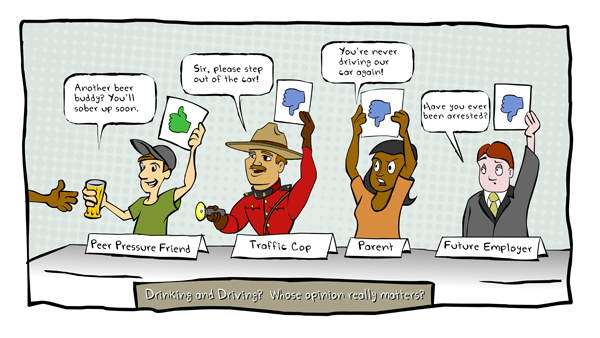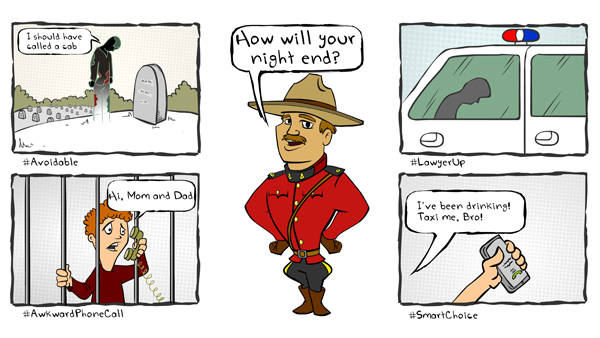Common menu bar links
Impaired Driving Lesson Plan (Grades 11 & 12)
Note: Contact us by e-mail to receive the Lesson Plan PDF version. Requests will be answered between 7:00am and 3:00pm, Monday to Friday.
Objectives:
- To discuss impaired driving and the impact it can have.
- To identify strategies to deal with peer pressure.
- To discuss the social and legal consequences of impaired driving.
Material:
Reference documents are found at the end of this lesson plan.
- Activity #1: Fact or Fiction - The Truth about Impaired Driving (11-12.1 Reference)
- Activity #2: Scoping out the Scene - Peer Pressure (11-12.2 Reference)
- Activity #3: Impaired Driving - Only Alcohol Counts, Right? (11-12.3 Reference)
- Activity #5: How to Make a Difference (11-12.5 Reference)
Handout:
Other Materials:
- SMART board/chalk board to summarize responses on
- Computer/projector to display images
- Fatal Vision Goggles (if possible)
- Masking tape
- Chart paper
- Markers
Time:
- Icebreaker
- Introduction 5 minutes
- Activity #1: Fact or Fiction - The Truth about Impaired Driving 5 minutes
- Activity #2: Scoping out the Scene - Peer Pressure 10 minutes
- Activity #3: Impaired Driving - Only Alcohol Counts, Right? 15 minutes
- Activity #4: Fatal Vision Goggles 10 minutes
- Activity #5: How to Make a Difference 10 minutes
- Conclusion 5 minutes
Total: 60 minutes
NOTE: Activities #4 and 5 can be shortened or lengthened depending on time requirements.
Presenter Preparation:
- Review the Impaired Driving section of the Centre for Youth Crime Prevention.
- Review the Objectives of this lesson plan.
- Identify ways in which you are personally linked to the subject matter. This presentation is general in nature, and will be more effective if you tailor it to your personal experiences, the audience and your community.
- Guest speakers can have a real impact. If there is someone in your community who has suffered a loss or has been impacted by impaired driving, invite them to speak with the youth, (e.g. bring in a traffic officer, representative from MADD Canada). NOTE: Activities will need to be removed to allow for this time adjustment.
- Print the lesson plan and reference documents.
- Print required handouts. Make a few extra copies just to be sure.
- Gather material needed.
- Ensure your location has the technology you require (computer, projector, SMART Board, etc.)
Lesson:
A) Icebreaker
- Place cartoons on the board for the students to see as they walk in to class.
- Discuss the cartoon briefly and how impaired driving is portrayed in the cartoon.

[ Image Description/Larger Image Comic #4 Drinking and Driving ]

[ Image Description/Larger Image Comic #5 Drinking and Driving ]
B) Introduction
- Introduce yourself.
- Tell the students about your job and why you are there to talk to them. Tell them that in today's class they will talk about impaired driving, the impacts it can have, and the ways they can deal with difficult situations involving someone they know who may have had too much to drink (or be impaired by other means).
- If you are a police officer, briefly discuss the role of police officers when it comes to impaired driving, (i.e. your experience dealing with young impaired drivers, or delivering notifications of next of kin).
- Pass out one index card to each student. Explain that this card is to be used for them to write down any question they may have. The presenters will collect them towards the end of the presentation and answer the questions anonymously in front of the group.
C) Activity #1: Fact or Fiction - The Truth about Impaired Driving
Goal: To test the students' knowledge on impaired driving.
Type: Think and share
Time: 10 minutes
Step #1:
- Hand out Activity #1: Fact or Fiction—The Truth About Impaired Driving (11–12.1 Handout). Give students a few minutes to complete the quiz independently.
Step #2:
- Consulting the reference sheet Activity #1: Fact or Fiction—The Truth About Impaired Driving (11-12.1 Reference), review the answers with the students. Be sure to answer any questions that the students may have. Provide any relevant real life examples.
D) Activity #2: Scoping out the Scene - Peer Pressure
Goal: To teach students skills to overcome peer pressure that may be associated with impaired driving by looking at various scenarios.
Type: Acting/improvisation and discussion.
Time: 15 minutes
Step #1:
- Explain to students that they may find themselves in tough situations where they are dealing with a friend, family member or someone else they know who may want to drive after they have had too much to drink. It is important that they are able to recognize when this occurs, and have the confidence to act accordingly.
- Tell students that they are going to be placed into groups of 3 or 4 and given a scenario.
- Hand out one scenario from Activity #2: Peer Pressure of Impaired Driving (11-12.2 Reference) to each group.
- Tell the students they have 5 minutes to create a skit based on the scenario provided. At the "What do you do?" point, the students are to say "STOP" and then continue their skit by acting out what they should do if the situation should arise.
- Each skit should be no more then 1-2 minutes long.
- At the end of the skits, discuss the importance of making safe decisions and being confident enough to act on them when it comes to impaired driving.
E) Activity #3: Alcohol vs. Drugs - Is there a Difference?
Goal: To show students that drug use and driving can be just as dangerous as drinking and driving
Type: Discussion and chart
Time: 10 minutes
Step #1:
- Ask students if they think doing drugs and driving is common among their peers.
- Ask them specifically about marijuana use and driving, as some studies found that often teens often don't see any issues with using marijuana and driving.
Step #2:
- Ask students what it is about doing drugs, specifically marijuana, that could make someone think it's safer to smoke and drive than to drink alcohol and drive (e.g. doesn't have the same effects, not focused on in MADD campaigns).
- Create a T-Chart on the board/SMART Board/chart paper with the titles Alcohol and Drugs. Using Activity 3: Alcohol vs. Drugs—Is there a Difference? (11-12.3 Reference), call out the symptoms and ask students which ones go with which substance, then write it under that category.
- When all of the symptoms are sorted, tell students that most are possible symptoms of both alcohol and drug use.
- Emphasize the similarities in effects between alcohol and drugs, and how both are still considered impaired driving.
F) Activity #4: Fatal Vision Goggles
Goal: To demonstrate to students how alcohol impairs their vision.
Type: Interactive Activity
Time:10 minutes
Step #1:
- Play the MADD Video "Glasses" http://www.youtube.com/watch?v=MrhV3QTkNyw
- Explain to students that this is comparable to what it's like to drive while impaired, and that vision is not their only sense that can be impaired.
Step #2
- If available, in a safe area of the classroom allow students to try the "Fatal Vision Goggles."
- Set up a path with masking tape the length of the classroom and have students try to walk on the line.
- Alternatively, ask them to draw a picture on a piece of paper while wearing the goggles.
G) Activity #5: How to Make a Difference
Goal: To have students apply what they've learned to promote sober driving amongst their peers.
Type: Apply and create
Time:5 minutes
Step #1: (Homework)
- Tell the students that based on what they already know about impaired driving and what they learned today, they're to design a social media campaign promoting sober driving.
- Tell them that they can create their campaign using logos, slogans, hashtags, guest speakers, music, and any other multi-media tools.
Step #2:
- Have students share their ideas.
- If need be, consult Activity #5: How to Make a Difference? (11-12.5 Reference)to share the definitions with the class.
H) Conclusion
- To conclude the lesson, summarize the important points and highlights of your discussion.
- Collect all index cards from the students. Take some time to answer any questions from the cards that the students may have had.
- Leave students with information about how to contact you if they have any follow up questions they didn't want to ask in class.
Reference Documents
Activity #1: Fact or Fiction - The Truth about Impaired Driving (11-12.1 Reference)
| Statement | True | False | Not Sure |
|---|---|---|---|
| 1. If your BAC (Blood Alcohol Concentration) is below the legal limit, you cannot be charged with an impaired driving offence. | X | ||
| 2. Your driver's license can be suspended immediately by a police officer for impaired driving. | X | ||
| 3. Having only one drink per hour allows you to stay below the legal limit. | X | ||
| 4. If you are impaired while operating a snowmobile on your own property you cannot be charged with impaired driving. | X | ||
| 5. An impaired driving charge is nothing to be concerned about. You pay the ticket and that's that. | X | ||
| 6. If you have had too much to drink, drinking a cup of coffee and taking a cold shower will sober you up enough to drive. | X | ||
| 7. Driving under the influence of drugs is less risky than driving under the influence of alcohol. | X | ||
| 8. If you suspect that someone has had too much to drink but they assure you they are okay to drive, you should trust their judgment and get in a vehicle with them. | X | ||
| 9. Any drug that changes your mood or the way you feel (e.g. legal, illegal drugs, prescription drugs or over-the-counter drugs) impairs your ability to drive. | X | ||
| 10. If you are under 21 years of age and a fully licensed driver, it's okay to have one drink and drive. | X |
Activity #2: Scoping out the Scene - Peer Pressure (11-12.2 Reference)
Cut out the scenarios and distribute to students for the role playing activity. Each group should have a different scenario.
(Adapted from OPHEA, "Draft" Beer, Not People, http://www.opheaprograms.net/roadsafety/en/us_en.html)
Activity #3: Impaired Driving - Only Alcohol Counts, Right? (11-12.3 Reference)
Alcohol and drug use can affect everyone differently, but generally they result in:
- Difficulty judging distances
- Panic, anxiety
- Impaired short term memory and coordination
- Slowed thinking
- Confusion
- Lower inhibitions
- Impaired judgment
- Slurred speech
- Slower reflexes
- Blurred vision
Activity #5: How to Make a Difference (11-12.5 Reference)
Impaired driving is driving while you are under the influence of alcohol or drugs, or a combination of both.
| Definition | Impacts |
|---|---|
Alcohol impaired driving:driving after having consumed any amount of alcohol. |
Everyone reacts differently to alcohol, so it's hard to say what the exact effects will be. Some people feel happy, some are sad, and some just get really sleepy. Drinking heavily impairs your judgment and your risk of getting into an accident increases dramatically. |
Drug impaired driving: driving after consuming drugs – legal, illegal, prescription, or even over-the-counter. |
|

